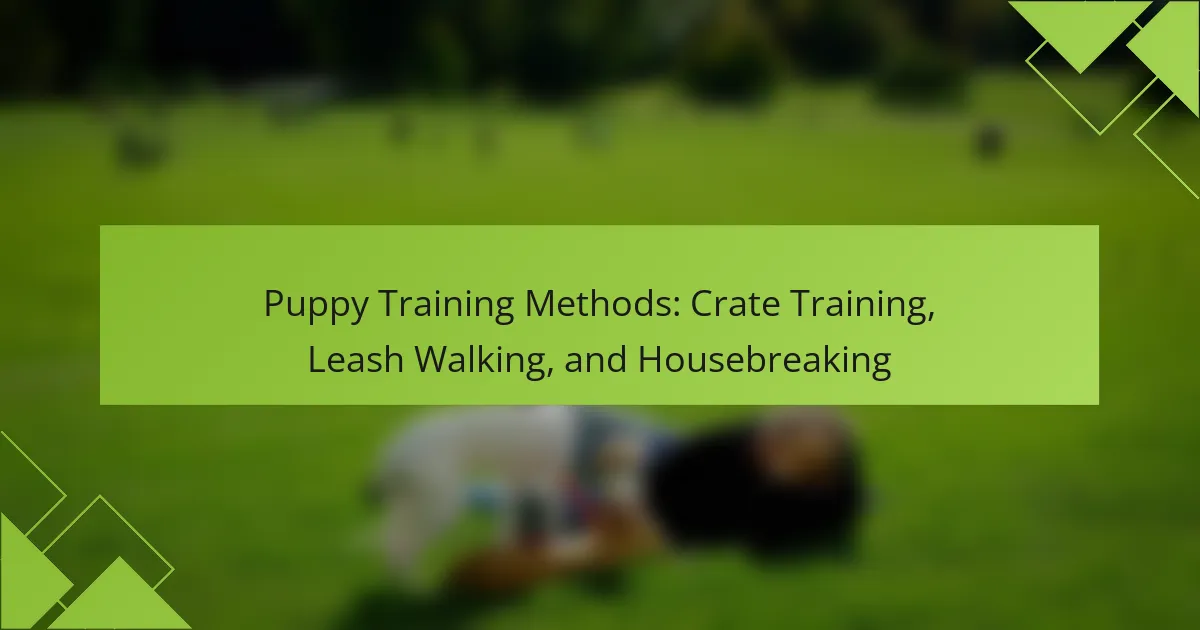Effective puppy training methods can lead to a well-behaved dog and a harmonious relationship with its owner. This article explores crate training to create a secure environment, leash walking for discipline and control, and housebreaking to establish bathroom routines. Each method requires dedication and an understanding of canine behaviour to overcome common training challenges. Utilizing tools like training collars and clickers can enhance the training experience and foster positive outcomes.

What are the Key Principles of Puppy Training Methods?
Puppy training methods focus on effective techniques like crate training, leash walking, and housebreaking. These methods emphasize positive reinforcement, consistency, and patience to build a strong foundation for a well-behaved dog.
Crate training teaches puppies to feel secure in a designated space, promoting good behaviour. Leash walking instills discipline and control during outdoor activities. Housebreaking establishes a routine for bathroom habits, essential for indoor living.
Each method requires dedication and understanding of the puppy’s needs. For example, crate training can reduce anxiety and prevent destructive behaviour when done correctly. Adopting these principles fosters a harmonious relationship between puppy and owner.
How does Crate Training Benefit Puppies and Owners?
Crate training benefits puppies and owners by providing a safe space for the puppy, promoting security, and aiding in housebreaking. It helps establish a routine, reduces anxiety, and minimizes destructive behaviour. Additionally, it fosters a stronger bond between the puppy and the owner through positive reinforcement techniques.
What Techniques are Effective for Leash Walking?
Effective techniques for leash walking include positive reinforcement, consistent commands, and gradual exposure to distractions. Positive reinforcement encourages desired behaviour through treats and praise. Consistent commands establish clear expectations. Gradual exposure helps puppies adjust to various environments, reducing anxiety and promoting confidence.
How Can Housebreaking be Successfully Achieved?
Successful housebreaking can be achieved through consistency, positive reinforcement, and a structured routine. Establish a designated bathroom area outside and take the puppy there frequently, especially after meals and naps. Use praise or treats immediately after they eliminate in the right spot to reinforce the behaviour. Monitor the puppy indoors to prevent accidents and establish a regular feeding schedule to predict bathroom needs. Patience is essential, as each puppy learns at their own pace.

What Challenges Do Owners Face in Puppy Training?
Owners face several challenges in puppy training, including consistency, patience, and understanding canine behaviour. Crate training can lead to anxiety if not introduced correctly. Leash walking often presents issues with pulling or distraction, requiring owners to develop effective techniques. Housebreaking demands a commitment to routine and monitoring, as accidents can hinder progress. Addressing these challenges is essential for successful puppy training.
Which Common Mistakes Should Be Avoided?
Avoid common mistakes like inconsistency in training methods, neglecting socialisation, and using negative reinforcement. These errors can hinder your puppy’s learning process. Consistency is crucial; use the same commands and techniques. Socialisation helps your puppy adapt to various environments. Positive reinforcement fosters a trusting relationship, ensuring effective training outcomes.
How Can Behavioural Issues Be Addressed During Training?
Behavioural issues during puppy training can be effectively addressed through consistent methods and positive reinforcement. Establish clear boundaries and routines to create a structured environment.
1. Use crate training to provide a safe space, helping the puppy learn to control its behaviour.
2. Implement leash walking to teach proper manners and reduce pulling, reinforcing desired actions with treats.
3. Focus on housebreaking by establishing a regular schedule for bathroom breaks and rewarding successful outings.
These methods encourage good behaviour while building a trusting relationship between the puppy and trainer.

What Tools and Resources Enhance Puppy Training?
Various tools and resources enhance puppy training, including training collars, clickers, and training pads. These tools facilitate effective methods such as crate training, leash walking, and housebreaking.
Training collars provide control and communication during leash walking. Clickers serve as a positive reinforcement tool, marking desired behaviours. Training pads assist in housebreaking by providing a designated area for puppies to relieve themselves indoors.
Additionally, online resources, such as training videos and articles, offer guidance on best practices. Engaging with professional trainers can also provide tailored strategies for specific puppy behaviours.
Which Crate Options are Best for Different Breeds?
Different breeds require specific crate options to ensure comfort and safety during training. Large breeds benefit from spacious crates, while smaller breeds thrive in compact, secure spaces.
| Breed Type | Recommended Crate Size | Key Features |
|——————|————————|—————————-|
| Small Breeds | 24-30 inches | Cozy, den-like environment |
| Medium Breeds | 30-36 inches | Adjustable dividers |
| Large Breeds | 36-42 inches | Durable materials |
| Extra Large Breeds | 42-48 inches | Heavy-duty construction |
| Puppies | Size varies by breed | Expandable options |
| Senior Dogs | Size varies by breed | Easy access design |
Choosing the right crate enhances the training experience, promoting a sense of security for each breed.
What Leash Types are Recommended for Various Training Styles?
For various training styles, recommended leash types include standard leashes, retractable leashes, and training leashes. Standard leashes offer control, retractable leashes provide flexibility, and training leashes allow for distance while maintaining command. Each type suits different training approaches, enhancing effectiveness.
How Can Training Apps Support Puppy Owners?
Training apps can significantly support puppy owners by providing structured guidance for crate training, leash walking, and housebreaking. These apps offer interactive tools, step-by-step tutorials, and progress tracking to enhance the training experience.
For crate training, apps may include timers and reminders to help establish a routine, ensuring puppies feel secure in their space. In leash walking, users can access tips on proper techniques and safety measures, promoting effective communication between owner and puppy. Housebreaking features often involve tracking elimination habits, helping owners recognise patterns and reinforce positive behaviours.
Additionally, many apps provide access to community forums, allowing owners to share experiences and seek advice, fostering a supportive environment. This multifaceted approach empowers puppy owners to train effectively, leading to well-behaved pets.

What Are the Unique Attributes of Different Puppy Training Methods?
Crate training, leash walking, and housebreaking each have unique attributes that cater to different training needs. Crate training emphasizes security and comfort, helping puppies develop a sense of den-like safety. Leash walking focuses on teaching control and proper behaviour outdoors, enhancing socialisation skills. Housebreaking prioritises establishing a routine for bathroom habits, which is essential for indoor living. Each method serves distinct purposes while contributing to a well-rounded training experience.
How Does Crate Training Differ Across Breeds?
Crate training methods vary significantly across dog breeds due to differences in temperament and instincts. Breeds like Labrador Retrievers often adapt quickly to crate training, finding comfort in confined spaces. In contrast, more independent breeds, such as Shiba Inus, may resist confinement, requiring patience and gradual acclimatization.
Additionally, smaller breeds, like Chihuahuas, may feel secure in a crate but can develop anxiety if not properly introduced. On the other hand, larger breeds, such as Great Danes, may require larger crates and more space to feel comfortable.
Understanding these breed-specific traits can enhance the effectiveness of crate training, ensuring a successful transition for each dog.
What Specific Techniques Work Best for Energetic Puppies?
Crate training, leash walking, and housebreaking are effective techniques for energetic puppies. Crate training provides a safe space, helping puppies learn to relax and reducing anxiety. Leash walking promotes exercise and socialisation, essential for their development. Housebreaking establishes routine, teaching puppies where to relieve themselves. Consistency and positive reinforcement are crucial in all methods to ensure success.

What Are the Long-Term Benefits of Effective Puppy Training?
Effective puppy training provides long-term benefits such as improved behaviour, stronger bonds, and enhanced socialisation. Crate training fosters a safe space, aiding in housebreaking and reducing anxiety. Leash walking teaches discipline and promotes exercise, ensuring a well-adjusted dog. Consistent training enhances obedience, making future training easier and reducing behavioural issues.
How Does Early Training Impact Adult Dog Behaviour?
Early training significantly influences adult dog behaviour by establishing essential habits and social skills. Effective methods like crate training, leash walking, and housebreaking help shape a dog’s temperament and obedience.
Crate training creates a safe space, promoting security and reducing anxiety. Dogs trained in this manner often exhibit better behaviour in unfamiliar situations. Leash walking teaches control and discipline, leading to a more manageable adult dog. Housebreaking instills cleanliness and routine, which are crucial for a well-adjusted pet.
Research shows that dogs trained early are less likely to develop behavioural issues. For example, a study indicated that early socialisation reduces aggression and fearfulness in adult dogs. This underscores the importance of implementing structured training methods during the puppy stage.
What Role Does Socialisation Play in Puppy Development?
Socialisation is crucial in puppy development as it shapes behaviour and temperament. Proper socialisation leads to well-adjusted dogs that are comfortable in various environments. Early exposure to different people, animals, and situations helps prevent behavioural issues later in life. For example, puppies that experience positive interactions during their formative weeks are more likely to exhibit confidence and reduced anxiety as adults. Engaging in puppy training methods like crate training, leash walking, and housebreaking also supports effective socialisation, enhancing the overall training experience.
What Best Practices Ensure Successful Puppy Training?
Consistent training methods ensure successful puppy training. Effective techniques include crate training, leash walking, and housebreaking, which foster discipline and comfort.
Crate training provides a safe space for puppies, helping them develop a sense of security. Leash walking teaches control and socialisation, essential for outdoor experiences. Housebreaking establishes routine, promoting cleanliness and reducing accidents indoors.
Incorporating positive reinforcement enhances these methods, encouraging desired behaviours. Regular practice and patience are vital for long-term success.
